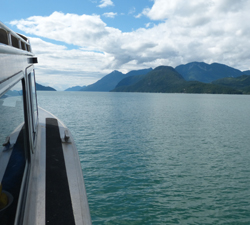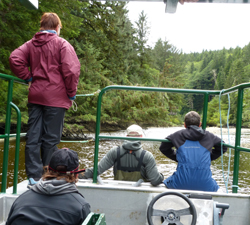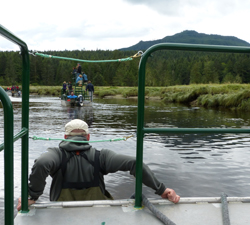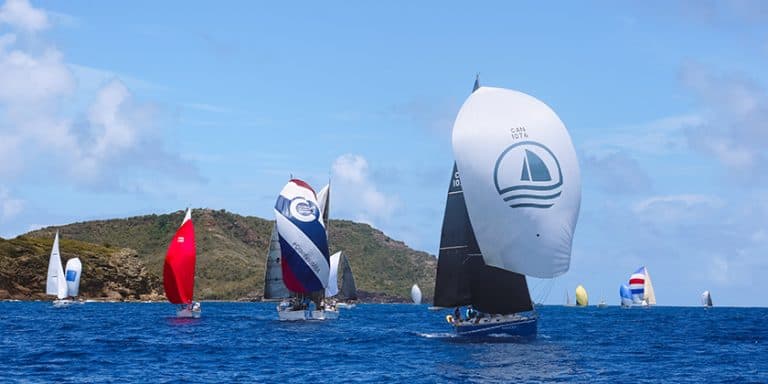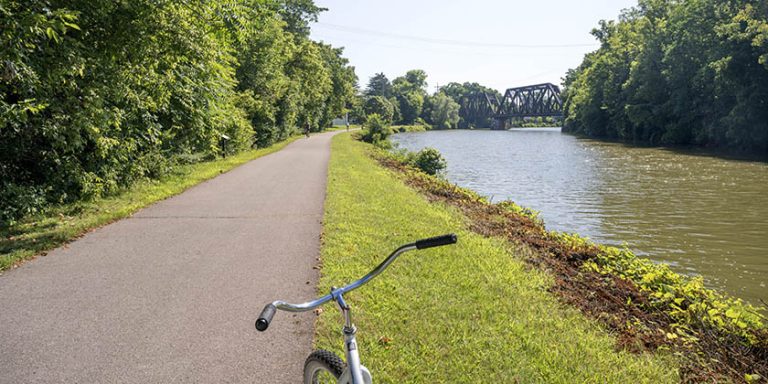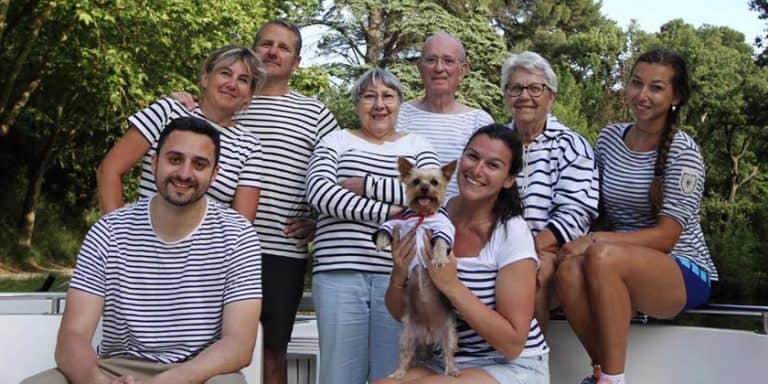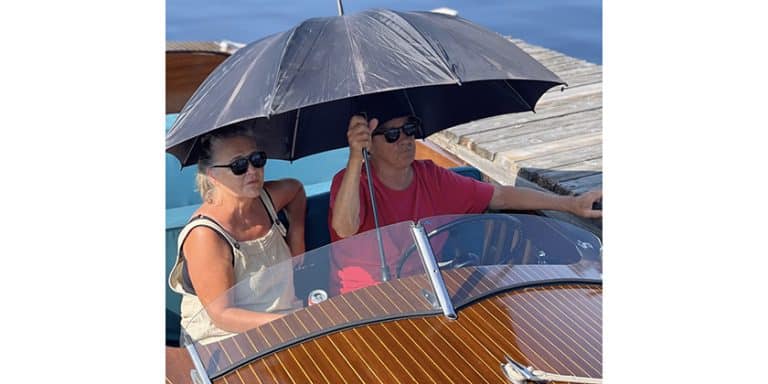The Grizzlies of Glendale
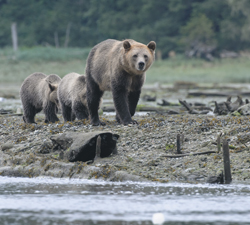
 The Grizzlies of Glendale
The Grizzlies of Glendale
Glendale Cove, on BC’s Knight Inlet, is protected habitat for grizzly bears – and the ideal spot to rub shoulders with these rulers of the coastal rainforest.
By Duart Snow
Cruisers who venture north of the BC coast’s major tidal rapids quickly learn that they’re not in Kansas anymore. The big passes not only divide the popular cruising grounds to the south from the less-travelled country to the north. They are gateways between the “civilized” south – where humans are in charge – and the “wild kingdom” that is home to some of North America’s most formidable wildlife.
You don’t have to venture far beyond the rapids to see signs and hear stories of black bears, grizzly bears and cougars. Black bears are a common sight as they forage along beaches and channels north of Desolation Sound, and finding their fresh scat adds an extra thrill to hikes ashore. Grizzlies are much harder to spot away from the remote and rugged coastal mainland, while cougars are the ghosts of the wilderness: stealthy predators that worry folks up here way more than the bears do.
At Port Harvey, our first stop on a recent cruise to the Broughtons, we learned that a grizzly sow and her cub had been cruising back and forth across East Cracroft Island, turning up alternately near the marinas at Port Harvey and Lagoon Cove. Their regular beach visits were the talk of the docks. We weren’t lucky enough to see them, but we jumped at the chance to join a tour to nearby Glendale Cove, a tidal estuary on Knight Inlet that attracts one of BC’s largest concentrations of grizzlies. We hoped to see bears up close and learn more about living with them…in peace.
Tide Rip Grizzly Tours operates from Telegraph Cove on Vancouver Island but collected us at Lagoon Cove en route to Glendale, which lies about 25 miles farther up Knight, North America’s longest inlet (see sidebar). We joined naturalist Derek Kyostia, biologist Matt Allen, a British student spending his summer on the West Coast, and eight other guests aboard a 25’ crew boat for the day’s adventure.
The trip to Glendale is spectacular in itself. Knight Inlet slices through densely forested coastal mountains – their steep slopes and cliffs drop into deep water that is tinted a brilliant milky turquoise by glacial deposits from the big rivers that feed the inlet. Cruisers can visit Glendale Cove and explore Knight in their own boats, but big tides, strong currents and winds, and rocky shorelines with few anchorages beyond Glendale make it a challenging destination for cruisers or kayakers.
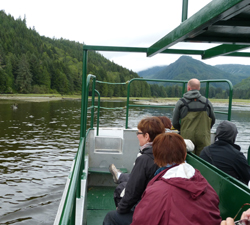 Like many harbours on this part of the coast, Glendale was once busy and populous. A salmon cannery and logging operation supported a population of up to 1,000 in their heyday but now only traces of industry remain. The Glendale Creek estuary is the heart of a special management zone where grizzly and black bears are protected from trophy hunting, and it is a centre of wilderness tourism focused on viewing the grizzlies in their natural habitat. A wilderness lodge now occupies the old cannery site.
Like many harbours on this part of the coast, Glendale was once busy and populous. A salmon cannery and logging operation supported a population of up to 1,000 in their heyday but now only traces of industry remain. The Glendale Creek estuary is the heart of a special management zone where grizzly and black bears are protected from trophy hunting, and it is a centre of wilderness tourism focused on viewing the grizzlies in their natural habitat. A wilderness lodge now occupies the old cannery site.
Glendale Cove is a notch in Knight Inlet’s rugged southern shoreline that gives way to a broad tidal flat at its head, where the creek meets the ocean. At a float on the cove’s west side, we transferred from the crew boat to a flat-bottomed aluminum skiff fitted with benches and a raised viewing platform and headed for the creek.
This is classic bear habitat: the wide tidal flat is thick with the sedge grass that bears feed on when they emerge from hibernation in the spring, and it supports late-summer runs of pink, chum and coho salmon that fatten them up for winter. In settings like this up and down the coast, cruisers can expect to encounter grizzly and black bears, especially when salmon are running.
There are eight to 10 resident bears in the Glendale management zone but the salmon runs draw up to 50 or 60 transient bears to the area. At just 41 square kilometres, the reserve is very small by comparison with the typical range of grizzlies: 100 square kilometers for females and 1,000 or more for males.
Bear Love
Kyostia is an experienced and engaging guide who made it clear how much he loves his bears. “Call me Beastmaster,” he joked. As we edged into the creek on a falling tide – which typically attracts bears in search of salmon – he explained that the bears emerge from their dens in March or April having lost about 40 percent of their body mass during hibernation. In the spring, they chow down on up to 70 kilograms of sedge grass a day, then forage for berries through the summer until the salmon arrive.
“They eat, they sleep, they poop, they have sex – it’s a perfect life,” as Kyostia put it.
 To pack on maximum weight before hibernating, the bears seek out female fish and eat the eggs, brain and skin because they are highest in calories and fat, leaving the remains and clawed male fish to the other inhabitants of the estuary. Sure enough, as we watched for bears, our company included a number of mature and juvenile bald eagles fishing and picking at salmon scraps.
To pack on maximum weight before hibernating, the bears seek out female fish and eat the eggs, brain and skin because they are highest in calories and fat, leaving the remains and clawed male fish to the other inhabitants of the estuary. Sure enough, as we watched for bears, our company included a number of mature and juvenile bald eagles fishing and picking at salmon scraps.
“The bears do the hard work,” said Kyostia. “Then the leftover carcasses feed the rest of the food chain – juvenile bears, eagles, ravens, gulls.”
The pink salmon run was under way during our August visit, and the sound of fish splashing in the shallows is a “dinner bell” for the bears, explained Allen. On cue, a sow and two first-year cubs emerged from the forest and ambled through the grasses a couple of hundred metres away from us. Known as Leonore – guides and naturalists name the resident bears – the sow is a nine-year-old with a thick coat that shades from golden brown and charcoal grey on her face, head and back to dark brown on her legs. She stopped occasionally to sniff the air, likely aware of our presence, and kept her distance. But she has charged Kyostia on two occasions: “I know it’s personal. I love her but I don’t think she loves me!”
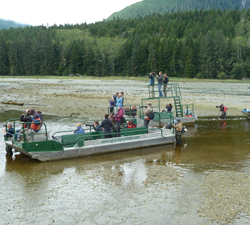 While we waited and hoped Leonore and cubs would edge closer, the tide fell until our barge grounded in mid-channel. “I’ve got everyone a perfectly stable platform for photos,” joked Kyostia. But what if a bear decided to come down to the river…? In fact, Leonore has charged when Kyostia’s boat was stuck – “just enforcing her bear space” and stopping about 15 metres away: “My knees were shaking.”
While we waited and hoped Leonore and cubs would edge closer, the tide fell until our barge grounded in mid-channel. “I’ve got everyone a perfectly stable platform for photos,” joked Kyostia. But what if a bear decided to come down to the river…? In fact, Leonore has charged when Kyostia’s boat was stuck – “just enforcing her bear space” and stopping about 15 metres away: “My knees were shaking.”
But he insisted that grizzlies give clear and obvious signs of aggression well before they charge. Staring, yawning and turning their bodies sideways all mean “back off.” Kyostia recently watched Leonore aggressively chase off an intruding male: “It was scary to watch – she went feral on him and he hasn’t come back.”
“We are witnesses here…we see life as it happens. So you see the good and you see stuff you wish you hadn’t seen at all” like the death of one of Leonore’s past cubs, he added.
Stuck firmly on the creek bottom, we felt a mix of relief and disappointment that Leonore and cubs came no closer. They worked their way across the estuary flats and back, then vanished into the forest once again. Eventually, we floated free on the flooding tide, and it was time for us to venture farther up the creek. Kyostia and Allen jumped overboard to push us through the shallows, then lowered the outboard when the water deepened. We chugged into the forest, Heart of Darkness fashion, where the trees began to close in on the creek.
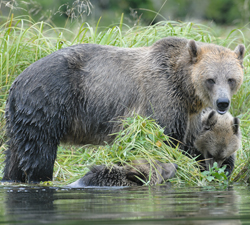 The outboard silent, we listened and waited for a while longer, but the grizzlies clearly had other plans. Our few minutes with Leonore and her cubs would be all for the day. Still, it was a thrill to see these magnificent animals on their own turf and on their own terms – more than enough to convince us that Kyostia was right about his beloved bears: “Bears shouldn’t be feared but they should be respected. We can learn a lot from these remarkable animals and from our glimpses into their lives.”
The outboard silent, we listened and waited for a while longer, but the grizzlies clearly had other plans. Our few minutes with Leonore and her cubs would be all for the day. Still, it was a thrill to see these magnificent animals on their own turf and on their own terms – more than enough to convince us that Kyostia was right about his beloved bears: “Bears shouldn’t be feared but they should be respected. We can learn a lot from these remarkable animals and from our glimpses into their lives.”
His words – especially the bit about respect – stayed with us as we sped back out through Knight’s turquoise water, and as we continued our cruise through the Broughtons, always wondering, with a little shiver, what the local critters were up to in the dark forest around us.
SIDEBAR – Knight Inlet Facts
• Knight Inlet is the largest of the major inlets on BC’s south coast – and longest inlet in North America. It reaches 67.5 nautical miles from Queen Charlotte Strait to the Klinaklini and Franklin rivers at its head. (See CHS Chart 5515 – Knight Inlet).
• Glendale Cove (50° 41.2’ N, 125° 43.7 W) lies about 50 nautical miles east of Queen Charlotte Strait. If you visit in your own boat, anchor in the bight south of Macdonald Point but be aware that strong summer westerly winds can blast right over the headland here.
Bear Tours
• Tide Rip Grizzly Tours www.tiderip.com
• Knight Inlet Lodge knightinletlodge.ca
Photos:
Photo 1 – Leonore, a nine-year-old female with two cubs, was an impressive sight on our visit to Glendale Cove – Matt Allen
Photo 2 – Guide Derek Kyostia edged our boat into the Glendale Creek estuary – Duart Snow
Photo 3 – Guide Derek Kyostia displayed a pink salmon carcass that had been clawed and abandoned by a bear – Duart Snow
Photo 4 – Grounded! At low tide, the viewing skiffs were stuck in the shallows and waiting for bear – Duart Snow
Photo 5 – Leonore and cubs forage int he Glendale Creek estuary – Duart Snow
